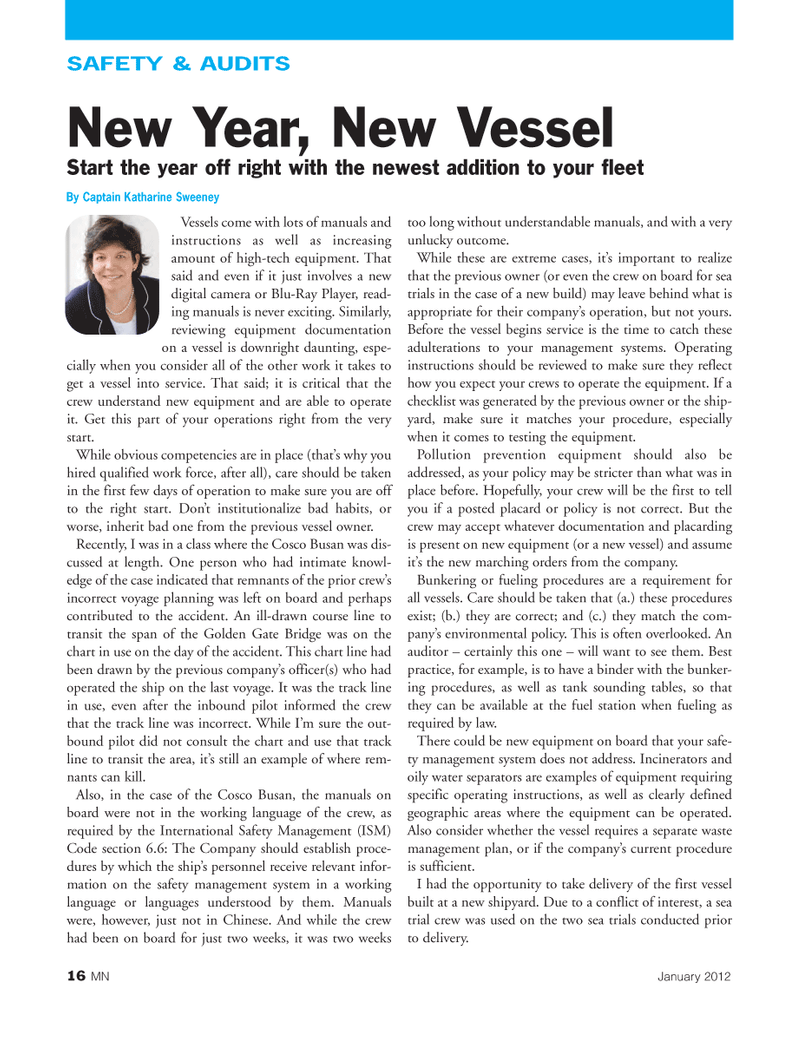
Page 16: of Marine News Magazine (January 2012)
Vessel Construction & Repair
Read this page in Pdf, Flash or Html5 edition of January 2012 Marine News Magazine
16MNJanuary 2012 SAFETY & AUDITSVessels come with lots of manuals and instructions as well as increasing amount of high-tech equipment. That said and even if it just involves a new digital camera or Blu-Ray Player, read- ing manuals is never exciting. Similarly, reviewing equipment documentation on a vessel is downright daunting, espe- cially when you consider all of the other work it takes to get a vessel into service. That said; it is critical that the crew understand new equipment and are able to operate it. Get this part of your operations right from the very start. While obvious competencies are in place (that?s why you hired qualified work force, after all), care should be taken in the first few days of operation to make sure you are off to the right start. Don?t institutionalize bad habits, or worse, inherit bad one from the previous vessel owner. Recently, I was in a class where the Cosco Busan was dis- cussed at length. One person who had intimate knowl- edge of the case indicated that remnants of the prior crew?s incorrect voyage planning was left on board and perhaps contributed to the accident. An ill-drawn course line totransit the span of the Golden Gate Bridge was on the chart in use on the day of the accident. This chart line had been drawn by the previous company?s officer(s) who had operated the ship on the last voyage. It was the track line in use, even after the inbound pilot informed the crew that the track line was incorrect. While I?m sure the out- bound pilot did not consult the chart and use that track line to transit the area, it?s still an example of where rem- nants can kill.Also, in the case of the Cosco Busan, the manuals on board were not in the working language of the crew, as required by the International Safety Management (ISM) Code section 6.6: The Company should establish proce- dures by which the ship?s personnel receive relevant infor- mation on the safety management system in a working language or languages understood by them. Manuals were, however, just not in Chinese. And while the crew had been on board for just two weeks, it was two weeks too long without understandable manuals, and with a very unlucky outcome. While these are extreme cases, it?s important to realize that the previous owner (or even the crew on board for sea trials in the case of a new build) may leave behind what is appropriate for their company?s operation, but not yours. Before the vessel begins service is the time to catch these adulterations to your management systems. Operating instructions should be reviewed to make sure they reflect how you expect your crews to operate the equipment. If a checklist was generated by the previous owner or the ship- yard, make sure it matches your procedure, especially when it comes to testing the equipment.Pollution prevention equipment should also be addressed, as your policy may be stricter than what was in place before. Hopefully, your crew will be the first to tell you if a posted placard or policy is not correct. But the crew may accept whatever documentation and placarding is present on new equipment (or a new vessel) and assume it?s the new marching orders from the company. Bunkering or fueling procedures are a requirement for all vessels. Care should be taken that (a.) these procedures exist; (b.) they are correct; and (c.) they match the com- pany?s environmental policy. This is often overlooked. An auditor ? certainly this one ? will want to see them. Best practice, for example, is to have a binder with the bunker- ing procedures, as well as tank sounding tables, so that they can be available at the fuel station when fueling as required by law. There could be new equipment on board that your safe- ty management system does not address. Incinerators and oily water separators are examples of equipment requiring specific operating instructions, as well as clearly defined geographic areas where the equipment can be operated. Also consider whether the vessel requires a separate waste management plan, or if the company?s current procedure is sufficient.I had the opportunity to take delivery of the first vessel built at a new shipyard. Due to a conflict of interest, a sea trial crew was used on the two sea trials conducted prior to delivery. By Captain Katharine SweeneyNew Year, New Vessel Start the year off right with the newest addition to your fleet MN#1 (1-17):MN 2011 Layouts 1/5/2012 4:17 PM Page 16

 15
15

 17
17
